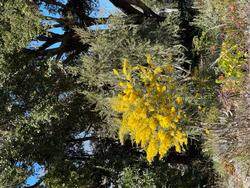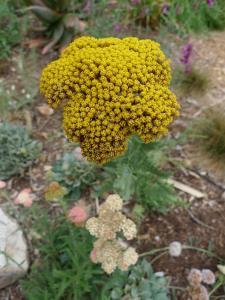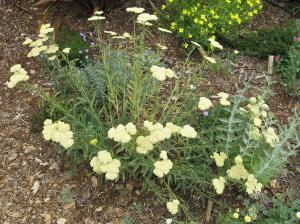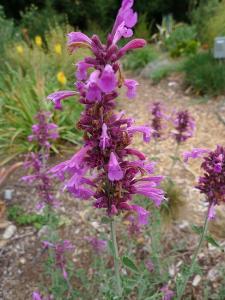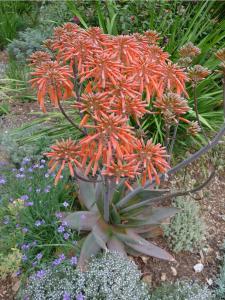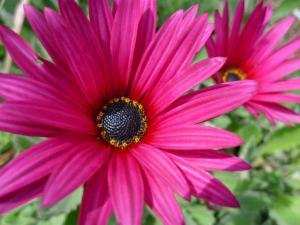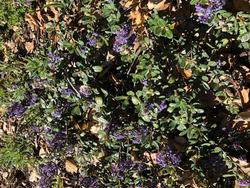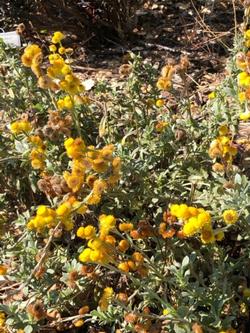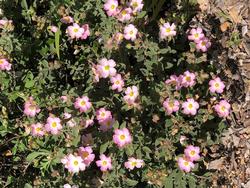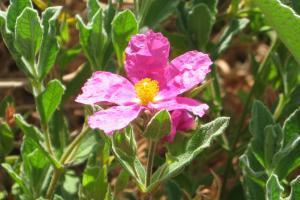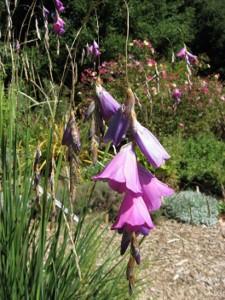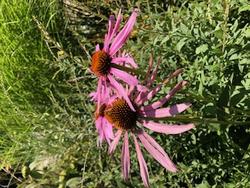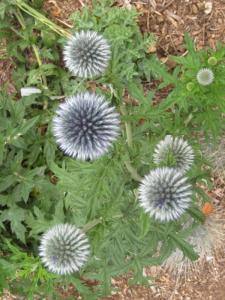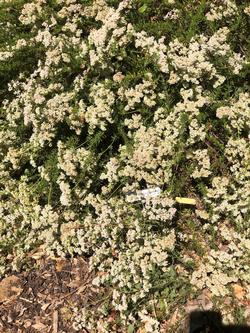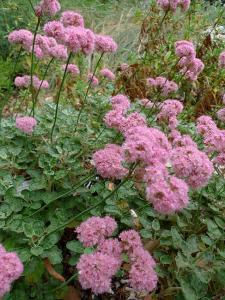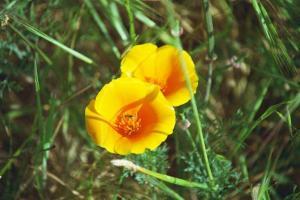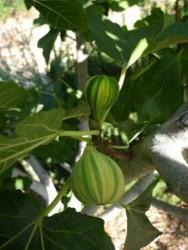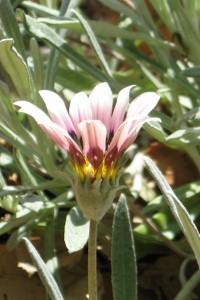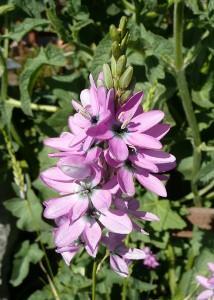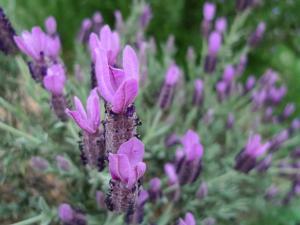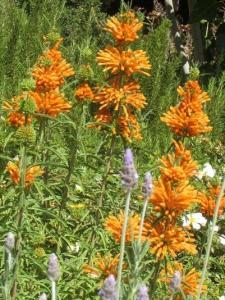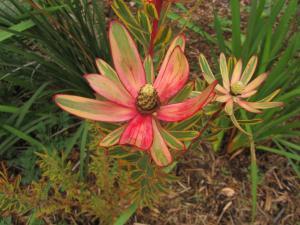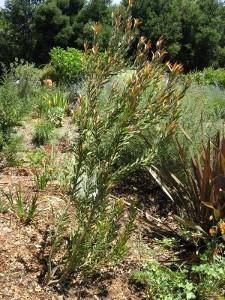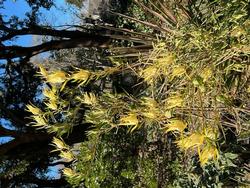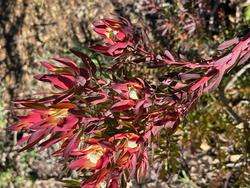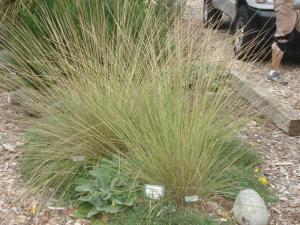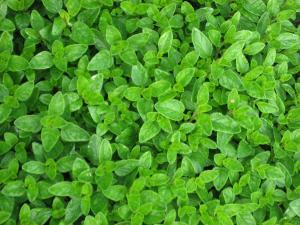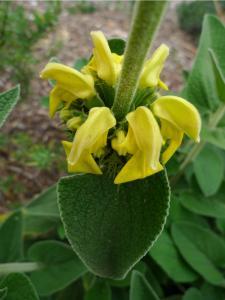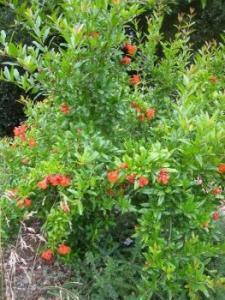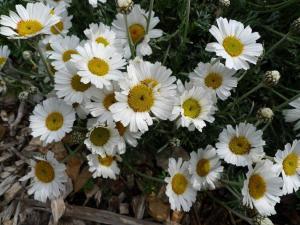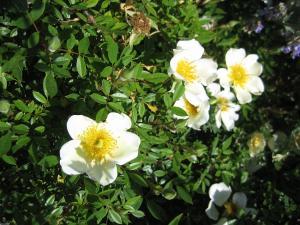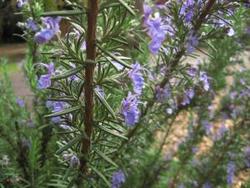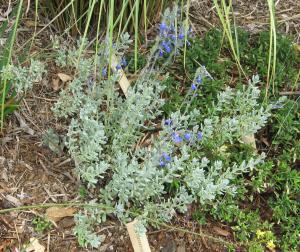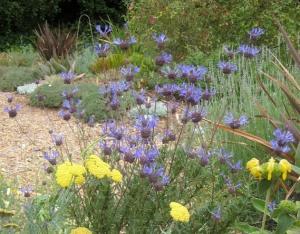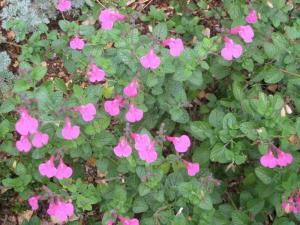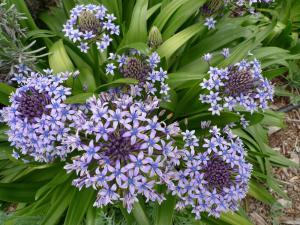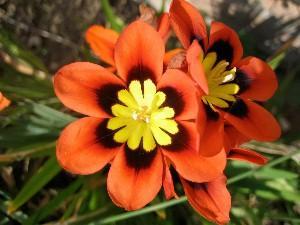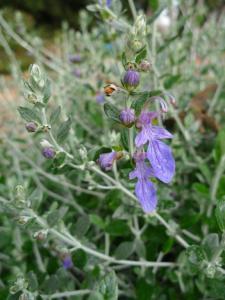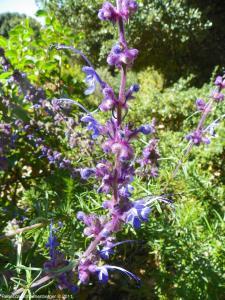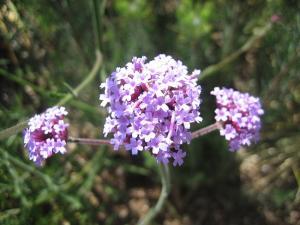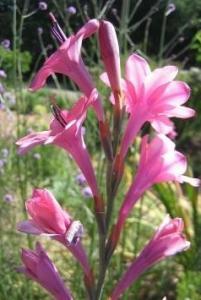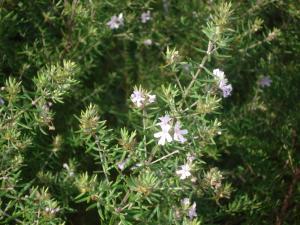Water Wise Plants
Here's a full list of all our water wise plants. You can also view an image gallery, or view the plants by categories.
Acacia cultriformis
Pronunciation
a-KAY-see-uh kul-tre-FORM-iss
Common Name
Knife-leaf acacia
Plant Type
Tree
Mature Size
10'-15' high x 10'-15' wide
Water Requirements
Very Low: water deeply several times a summer
Sun/Shade Requirements
Full sun
Wildlife
Flower Color
Yellow
Where to See
Maintenance- Design- Planting Tips
Acacia cultriformis is a tree that can reach 15' in both height and width. It has striking silver-gray leaves and is covered with vibrant yellow flowers in winter. This is a very drought tolerant tree and can go without water in summer once established. Although generally considered a problem-free tree, acacia branches can be more prone to breakage in windstorms than some other trees. Consider location carefully when planting.
PADG notes: The tree is a focal point during winter in the garden. It is pruned to a size that suits its small garden bed. During the dry season, drip irrigation is used every three weeks. |
Achillea ‘Moonshine’
Pronunciation
ah-KILL-lee-ah
Common Name
Yarrow ‘Moonshine’
Plant Type
Perennial
Mature Size
2 ft.
Water Requirements
Low: water every three weeks until the root ball is wet
Sun/Shade Requirements
Full sun
Wildlife
Flower Color
Bright yellow
Where to See
Maintenance- Design- Planting Tips
Achillea ‘Moonshine’ is a reliable mid-summer bloomer whose deep yellow flowers will stand out in a garden. Requiring very little maintenance, these plants are a magnet for butterflies and beneficial insects. The flowers have lots of nectar and the flat shape of the flower serves as a perfect landing pad for butterflies. Deadhead spent flowers to keep the plants looking fresh. Vigorous clumps can be divided in the winter. |
Achillea ‘Taygetea’
Pronunciation
ah-KILL-lee-ah tay-GET-ee-uh
Common Name
Yarrow ‘Taygetea’
Plant Type
Perennial
Mature Size
12 in. to 18 in. wide and tall
Water Requirements
Low: water every three weeks until the root ball is wet
Sun/Shade Requirements
Full sun
Wildlife
Flower Color
Creamy yellow
Where to See
Maintenance- Design- Planting Tips
‘Taygetea’ Greek yarrow is a cheerful, reliable summer bloomer. The flowers start out bright yellow in midsummer and fade to a more mellow shade over time. The grey-green foliage blends in well with many plants found in low water gardens. This cultivar of yarrow seems to be more drought tolerant than the popular Achillea millifolium.
Greek yarrow doesn't need a great deal of maintenance. To encourage reblooming, deadhead it regularly. This plant will spread, so don't plant it too tightly. |
Agastache
Pronunciation
ag-ah-STAK-ee
Common Name
Agastache
Plant Type
Perennial
Mature Size
3 ft. wide and 2 ft. tall
Water Requirements
Low: water every three weeks until the root ball is wet
Sun/Shade Requirements
Full sun
Wildlife
Flower Color
Pink
Where to See
Maintenance- Design- Planting Tips
Agastache are originally from the Southwest and Mexico, a climate that is somewhat different from Santa Clara County’s Mediterranean summer-dry climate. These plants require well-draining soil, but local soils tend to be slow-draining clay soils.
PADG notes: This unnamed cultivar of Agastache has been a mixed success in our gardens. |
Aloe striata
Pronunciation
AL-oh stree-AH-tuh
Common Name
Coral Aloe
Plant Type
Succulent
Mature Size
2 ft. to 3 ft. tall and 1 ft. to 2 ft. wide
Water Requirements
Low: water every three weeks until the root ball is wet
Sun/Shade Requirements
Full sun
Wildlife
Flower Color
Red-orange
Where to See
Maintenance- Design- Planting Tips
Like many succulents, Aloes are from South Africa. Aloe striata tolerates cold better than most aloes and grows successfully in the Bay Area. The large, broad, fleshy leaves and tall clusters of flowers are bold additions to the summer-dry perennial bed. As a bonus, hummingbirds and bees are attracted to its orange-red blossoms.
The only maintenance this plant needs is to cut back the inflorescence after the flowers have dropped off. Aloe striata is also easy to propagate. Remove the pups (baby plants) from the base of the plant, let the stems dry and harden, and then plant the cuttings in a pot of cactus soil mix. |
Arctotis ‘Purple Torch’
Pronunciation
ark-TOE-tiss
Common Name
African Daisy
Plant Type
Perennial
Mature Size
1 ft. to 1 1/2 ft. tall and wide
Water Requirements
Low: water every three weeks until the root ball is wet
Sun/Shade Requirements
Full sun
Wildlife
Flower Color
Purple
Where to See
Maintenance- Design- Planting Tips
Arctotis ‘Purple Torch’ is a low growing ground cover with gray felty leaves that are attractive even when there are no flowers. It begins blooming in the winter and continues until the weather gets hot. Other varieties of African daisy will bloom through the summer.
To keep Arctotis looking its best, the flowers should be regularly deadheaded when past their prime, and the plant should be replaced every few years. Cuttings root easily in the cool months. PADG notes: The Palo Alto Demonstration garden has planted ‘Purple Torch’ throughout the beds to unify the garden. It combines well with Bulbine frutescens, which blooms at approximately the same time. |
Ceanothus maritimus ‘Valley Violet’
Pronunciation
see-an-OH-thus muh-RIT-tim-mus
Common Name
Maritime ceanothus
Plant Type
Shrub
Mature Size
1'-3' high x 3'-8' wide
Water Requirements
Low: water every three weeks until the root ball is wet
Sun/Shade Requirements
Full sun
Wildlife
Flower Color
Maintenance- Design- Planting Tips
Ceanothus maritimus ‘Valley Violet’ is a California native and a UC Davis Arboretum All-Star. This low growing Ceanothus has a wide spread and can be an effective ground cover. It has dark, blue-green foliage that contrasts nicely with its purple flowers, which bloom from winter into spring. Be aware that all Ceanothus develop buckthorns as they age that can be very sharp.
PADG notes: Several varieties of Ceanothus were planted several years ago in the Native Bed at the Palo Alto Demonstration Garden. As of 2022, Ceanothus maritimus ‘Valley Violet’ is doing the best in the group. It is very drought tolerant and is living up to its All-Star status with the garden’s dry season irrigation cycle. Established plants are watered once every three weeks with drip lines. |
Chrysocephalum apiculatum
Pronunciation
kry-soh-SEE-uh-lum uh-pik-yoo-LAY-tum
Common Name
Silver and Gold Everlasting
Plant Type
Perennial
Mature Size
1' high x 2'-3' wide
Water Requirements
Low: water every three weeks until the root ball is wet
Sun/Shade Requirements
Full sun
Wildlife
Flower Color
Where to See
Maintenance- Design- Planting Tips
Chrysocephalum apiculatum is a low growing perennial strawflower with standout silver foliage and yellow flowers. Like all strawflowers, the fresh spring blooms retain their color as they dry and last on the plant for long periods. When established this is a very drought tolerant plant. It works well near the front of a border but give space for its spread. It should not be planted next to the border’s edge. Trim the flowers when they become unsightly and lightly shape the plant for the next spring bloom. Do not prune heavily.
|
Cistus x argenteus ‘Silver Pink’
Pronunciation
SIS-tus x (ar-JEN-tee-us)
Common Name
Rock Rose
Plant Type
Shrub
Mature Size
2'-3' high x 4'-5' wide
Water Requirements
Low: water every three weeks until the root ball is wet
Sun/Shade Requirements
Full sun
Wildlife
Flower Color
Pink and White
Where to See
Maintenance- Design- Planting Tips
Cistus x argenteus ‘Silver Pink’ has small flowers that densely cover the plant in the spring. At the end of the season the flowers drop off cleanly. This beautiful evergreen shrub naturally grows into a neat, compact mound, with dense, gray-green foliage. It should never be pruned heavily. Like many drought tolerant plants, a heavy pruning can kill it or leave it misshapen. Instead, be sure to allow enough space for the mature shrub in your landscape design so that pruning is not necessary.
|
Cistus x pulverulentus ‘Sunset’
Pronunciation
SIS-tus pul-ver-oo-LEN-tus
Common Name
Rockrose
Plant Type
Shrub
Mature Size
2 ft. tall and 6 - 8 ft. wide
Water Requirements
Low: water every three weeks until the root ball is wet
Sun/Shade Requirements
Full sun
Wildlife
Flower Color
Hot pink
Where to See
Maintenance- Design- Planting Tips
This hot pink rockrose is a long blooming, low growing shrub that can grow to six feet. There are several different rockrose cultivars, with flowers ranging from pink to white to lavender. Rockroses thrive in hot, dry areas. They like well-draining soil and will quickly die if overwatered. The plant can be pruned, but don’t cut into the wood because it may not resprout.
PADG notes: This plant tended to die within two years in the Demonstration Garden’s regularly watered clay soil. The rockrose was planted on a berm (small hill) and received minimal summer water. |
Dierama pendulum
Pronunciation
dy-er-AH-muh
Common Name
Fairy Wand, Angel’s Fishing Rod
Plant Type
Bulb
Mature Size
Leaves to 2 ft. long, stems 4-7 ft. tall
Water Requirements
Low: water every three weeks until the root ball is wet
Sun/Shade Requirements
Full sun
Wildlife
Flower Color
Purplish pink to pink to white
Where to See
Maintenance- Design- Planting Tips
Fairy Wand, also known as Angel’s Fishing Rod, has stunning flowers on long arching stems. It is certainly a “what is that?!” plant when it blooms in late spring and early summer. Be sure to put it in a spot that will showcase its tall blooms.
If the plant gets too big, the corms can be divided and replanted. Fairy Wand self sows, though heavy mulching may discourage seedlings. If reseeding is a problem, deadhead the flowers before they set seed. Fairy Wand is usually evergreen in Santa Clara County’s climate, but leaves can be cut back in mid-summer if they become unattractive. Otherwise, this is a trouble-free plant with a big impact when it blooms. PADG notes: Fairy Wand is said to need regular water, but a once every three weeks watering regime has worked well. |
Echinacea purpurea
Pronunciation
ek-ih-AY-shee-a pur-PUR-ee-ah
Common Name
Purple cone flower
Plant Type
Perennial
Mature Size
3'-4' high x 2' wide
Water Requirements
Low: water every three weeks until the root ball is wet
Sun/Shade Requirements
Full sun
Wildlife
Flower Color
Purple
Where to See
Maintenance- Design- Planting Tips
Echinacea purpurea is a green-leaved perennial that produces large purple, daisy-like blooms in the summer. It can grow to four feet in height and works well in the background of garden borders. It needs minimal drip irrigation, dies down after bloom, and resprouts in the spring with little extra maintenance required. |
Echinops ritro ‘Taplow Blue’
Pronunciation
EK-in-ops RIH-tro
Common Name
Globe Thistle
Plant Type
Perennial
Mature Size
2 - 4 ft. tall and 2 ft. wide
Water Requirements
Low: water every three weeks until the root ball is wet
Sun/Shade Requirements
Full sun
Wildlife
Flower Color
Bright blue
Where to See
Maintenance- Design- Planting Tips
Echinops has beautiful blue flowers that bloom spring through fall. The coarse leaves may not appeal to everyone, but they add a different texture to the garden. Echinops make a great cut flower. The spiky texture adds interest to flower arrangements.
Even with minimal water and no fertilizer, these plants need staking. Supports put in place in the early spring are quickly covered with foliage and hidden from view. To encourage new blooms and keep the plant looking fresh, remove the entire flowering stalk. |
Eriogonum fasciculatum
Pronunciation
er-ih-OG-uh-num fas-sik-yoo-LAH-tum
Common Name
California buckwheat
Plant Type
Shrub
Mature Size
2' high x 4'-5' wide
Water Requirements
Low: water every three weeks until the root ball is wet
Sun/Shade Requirements
Full sun
Wildlife
Flower Color
Maintenance- Design- Planting Tips
Eriogonum fasciculatum is a drought-tolerant California native shrub. Reaching only two feet in height with a four-to-five-foot spread, it is a good mid-border choice. The shrub has many branches that are densely covered with small, dark green, needle-like leaves and is covered with pinkish-white clusters of tiny flowers in spring which turn an attractive rust color in summer and fall. When not flowering, it is an attractive contrast to other plants in the mixed border. Trim flowers off when they become unsightly and lightly shape the plant. Do not prune heavily.
|
Eriogonum grande var. rubescens
Pronunciation
ee-ree-OG-oh-num GRAHN-day roo-BESS-ens
Common Name
Rosy Buckwheat
Plant Type
Shrub
Mature Size
1 ft. to 2 ft. tall and wide
Water Requirements
None: avoid summer water
Sun/Shade Requirements
Full sun
Wildlife
Flower Color
Maintenance- Design- Planting Tips
Rosy buckwheat, a California native from the Channel Islands, has rosy flowers in summer. It is one of the showiest and most compact of the buckwheats. Because of its size and neat growth habit, it makes a great filler plant in a native garden. Rosy buckwheat shines in late summer when the flowers turn from rosy to a coppery tint. The mellow colors of this plant blends well with other perennials. At the end of the coppery color phase, the blooms can be deadheaded to avoid a ratty look. Every few years, do a light pruning to new growth below the taller branches. The best time to do this pruning is in the late fall before the winter growth starts. Shape this plant every so often to keep its mounding form. Buckwheat requires some summer water the first year it is planted. After the first year, avoid summer water. The plants may only live three to five years, though sometimes longer. It freely reseeds so buying new plants may not be necessary. |
Eschscholzia californica
Pronunciation
esh-SHOLZ-ee-ah cal-ih-FOR-nih-kah
Common Name
California Poppy
Plant Type
Perennial
Mature Size
6 in. wide and 6 in. to 12 in. tall
Water Requirements
Low: water every three weeks until the root ball is wet
Sun/Shade Requirements
Full sun
Wildlife
Flower Color
Bright orange, golden, pale yellow, red, cream, rose
Where to See
Maintenance- Design- Planting Tips
California poppies look great in wild areas and are lovely massed. They make excellent temporary fillers in new beds and landscapes. California poppies can get by with almost no summer water, but they tend to look shabby and weedy under these conditions. To encourage continuous bloom, provide moderate amounts of water and trim the plants back to almost ground level when the foliage turns grey, and the plants lose their flowers. Although California poppies are perennials in the Santa Clara Valley, they can be treated as annuals. California poppies can be problematic because they are aggressive reseeders. They should be heavily thinned even in desired areas and removed entirely when undesired. They can reach one and a half feet wide in size and can smother other plants. Most retail nurseries and many hardware stores sell seeds for California poppies. Some mail order companies are good sources for some of the less common varieties of these California natives. Plant seeds in the fall for a spring show. Be sure to cover seeds with mulch to hide them from the birds and water regularly until they sprout if the winter rains have not arrived. |
Ficus carica ‘Panachée’
Pronunciation
FY-kus KAR-ih-kah
Common Name
Panachée Striped Tiger Fig
Plant Type
Tree
Mature Size
15 -30 ft.
Water Requirements
Low: water every three weeks until the root ball is wet
Sun/Shade Requirements
Full sun
Wildlife
Flower Color
None
Where to See
Maintenance- Design- Planting Tips
Tiger figs have beautiful striped, green fruit and large attractive leaves. The fruit requires a long warm season to ripen, which may not be possible in all parts of Santa Clara Valley. See the fig page for more information about growing figs.
PADG notes: PADG's two Tiger fig trees were too large for the modest-sized beds where they were planted, so had to be heavily pruned every year to keep them small enough. The Tiger figs have been removed and replaced with a dwarf fig cultivar called “Black Jack”. |
Gazania
Pronunciation
gay-ZAY-nee-uh
Common Name
Gazania
Plant Type
Groundcover
Mature Size
6 in. tall and 12 in. wide
Water Requirements
Low: water every three weeks until the root ball is wet
Sun/Shade Requirements
Full sun
Wildlife
Flower Color
Yellow, orange, white, and pink
Where to See
Maintenance- Design- Planting Tips
Gazanias are colorful, easy to grow, low water plants. Gazanias do better with only occasional water because they can become leggy if given regular water. Cultivars with silver foliage blend particularly well with other Mediterranean plants. Tired blooms can be deadheaded although it is not necessary. If a clump of plants becomes too crowded or too large, divide the plant during the cool season.
PADG notes: Gazanias have been planted along the edges of the Demonstration Garden to help tie together different beds. |
Grindelia hirsutula
Pronunciation
grin-DELL-ee-a hir-SU-too-la
Common Name
Great Valley Gumweed
Plant Type
Perennial
Mature Size
3 ft. wide x 2 - 6.6 ft (0.6 - 2 m) tall
Water Requirements
Very Low: water deeply several times a summer
Sun/Shade Requirements
Full sun
Wildlife
Flower Color
Yellow
Where to See
Maintenance- Design- Planting Tips
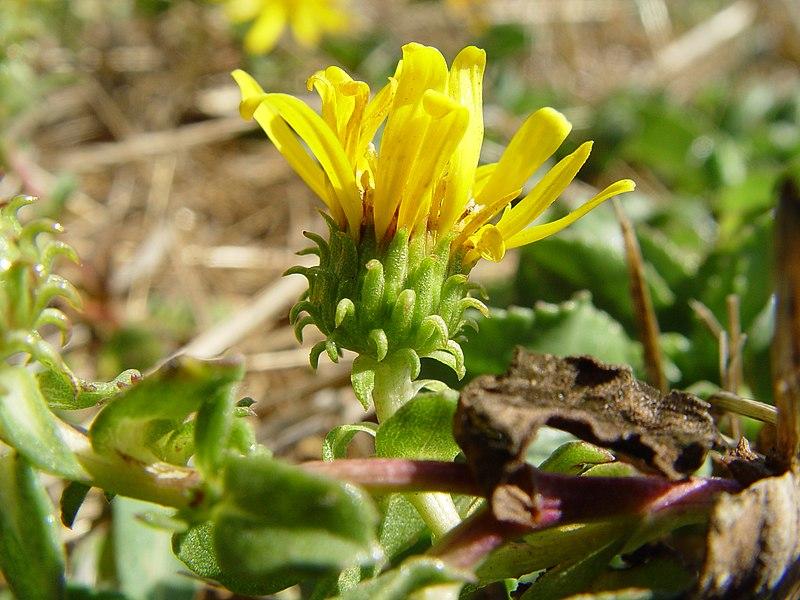
|
Ixia
Pronunciation
IKS-ee-uh
Common Name
African Corn Lily
Plant Type
Bulb
Mature Size
18 - 20 in. tall
Water Requirements
None: avoid summer water
Sun/Shade Requirements
Full sun
Wildlife
Flower Color
Cream, yellow, red, orange, and pink
Where to See
Maintenance- Design- Planting Tips
This versatile South African bulb is one of the best kept secrets of a Mediterranean garden. The late spring flowers come in pretty jewel tone colors that go well with many spring-blooming plants. The grass-like foliage on this plant can be removed when it goes brown and dormant in the summer. While it prefers no summer water, it can tolerate some.
|
Lavandula stoechas ‘Otto Quast’
Pronunciation
lah-VAN-dew-lah STOY-kas
Common Name
Spanish Lavender
Plant Type
Shrub
Mature Size
1 ft. to 2 ft. tall and 2 ft. to 3 ft. wide
Water Requirements
Low: water every three weeks until the root ball is wet
Sun/Shade Requirements
Full sun
Wildlife
Flower Color
Purple
Where to See
Maintenance- Design- Planting Tips
Lavenders are a favorite plant for low-water gardens with their aromatic foliage and showy spikes of scented flowers. Full sun and good drainage are essential for lavenders. Shear the plant after blooming to maintain a neat appearance and discourage the plant from becoming too large and woody. Lavender is a short-lived shrub that may need to be replaced when it becomes leggy or woody after about six years.
Lavandula stoechas is an early bloomer and will repeat bloom if deadheaded and given supplemental water. PADG notes: Several different types of lavenders are planted in the Demonstration Garden, including ‘Otto Quast’, a successful cultivar which is also a UC Davis Arboretum All-Star plant. |
Leonotis leonurus
Pronunciation
lee-oh-NO-tus lee-oh-NURE-us
Common Name
Lion’s Tail
Plant Type
Shrub
Mature Size
4 ft. to 6 ft. wide and tall
Water Requirements
Low: water every three weeks until the root ball is wet
Sun/Shade Requirements
Full sun
Wildlife
Flower Color
Orange-red
Where to See
Maintenance- Design- Planting Tips
This upright shrub from South Africa has bright eye-catching orange flowers. A single lion’s tail works well as a late summer/early fall garden focal point. The flowers can also be stunning in a flower arrangement.
Prune these shrubs in the early spring after the danger of frost is past to control size. Some gardeners prune them down to six inches from the ground; others just cut off half of the total height. How much to prune is a matter of deciding the desirable size of the plants in the garden. With no pruning at all, these plants can get very large, very quickly. Lion’s tail can be frost tender, but they rebound quickly. If this plant does get frost damaged, wait until after the danger of frost is past, then cut off the damaged parts. |
Leucadendron ‘Jester’
Pronunciation
lew-kuh-DEN-dron
Common Name
Jester Conebush
Plant Type
Shrub
Mature Size
4 ft. to 6 ft. tall and wide
Water Requirements
Low: water every three weeks until the root ball is wet
Sun/Shade Requirements
Full sun
Wildlife
Flower Color
Rose, red or yellow
Where to See
Maintenance- Design- Planting Tips
Leucadendrons are evergreen shrubs from South Africa and are related to Proteas. Some Leucadendrons have interesting cone-like heads with colorful bracts that may be used in flower arrangements; others are grown primarily for their foliage.
Plant Leucadendrons on one-foot mounds to encourage good drainage. Their color and size add a bit of drama to the beds, especially during periods where other plants are dormant. PADG notes: There are several different cultivars of Leucadendrons in the garden, including this one. ‘Jester’ is also known as ‘Safari Sunshine'. |
Leucadendron ‘Rising Sun'
Pronunciation
lew-kuh-DEN-dron
Common Name
Rising Sun Conebush
Plant Type
Shrub
Mature Size
6 ft. to 8 ft. tall and wide
Water Requirements
Low: water every three weeks until the root ball is wet
Sun/Shade Requirements
Full sun
Wildlife
Flower Color
Red
Where to See
Maintenance- Design- Planting Tips
Leucadendron ‘Rising Sun’ is a South African native, with beautiful reddish stems and terminal bracts (colorful flower-like leaves toward the end of a stem). Some Leucadendrons can be frost tender.
PADG notes: This Leucadendron stayed small, so pruning hasn’t been necessary. It may be because it was planted on top of a gravel mound and received limited water. However, we removed Rising Sun from the Palo Alto Demonstration Garden because it had a twisting way of growing that we didn't find attractive. |
Leucadendron salignum ‘Golden Tip’
Pronunciation
lew-kuh-DEN-dron sal-LIG-num
Common Name
Conebush
Plant Type
Shrub
Mature Size
4'-6' high x 4'-8' wide
Water Requirements
Moderate: water weekly until the root ball is wet
Sun/Shade Requirements
Full sun
Wildlife
Flower Color
Yellow
Where to See
Maintenance- Design- Planting Tips
Leucadendron salignum ‘Golden Tip’ is a structurally striking, upright shrub, with branches tipped with bright yellow bracts from winter into spring. Leaves are green but pick up a yellow hue during bloom time. Although considered drought tolerant, Leucadendrons require more water than most water wise plants. Even well-established plants can die during hot summers without enough water. PADG notes: This plant is watered every three weeks, but this is at the edge of their tolerance in the garden. They require little extra maintenance. |
Leucadendron salignum ‘Red Wing’
Pronunciation
lew-kuh-DEN-dron sal-LIG-num
Common Name
Conebush
Plant Type
Shrub
Mature Size
3'-4' high x 4'-6' wide
Water Requirements
Moderate: water weekly until the root ball is wet
Sun/Shade Requirements
Full sun
Wildlife
Flower Color
Red
Where to See
Maintenance- Design- Planting Tips
Leucadendron salignum ‘Red Wing’ is smaller than most leucadendrons and has deep red bracts from winter into spring. The green leaves pick up a red hue during bloom proving beautiful contrast in the mixed garden bed. Although considered drought tolerant, Leucadendrons require more water than most water wise plants. Even well-established plants can die during hot summers without enough water.
PADG notes: The plants are watered every three weeks at the Demonstration Garden, but this is right at the edge of their tolerance in the garden. They require little extra maintenance.
|
Muhlenbergia dubia
Pronunciation
muh-len-BER-jee-ah DOO-bee-uh
Common Name
Pine Muhly
Plant Type
Grass
Mature Size
2 ft. to 3 ft. wide and tall with plumes rising 4 ft. to 5 ft.
Water Requirements
Low: water every three weeks until the root ball is wet
Sun/Shade Requirements
Full sun
Wildlife
Flower Color
No flowers
Where to See
Maintenance- Design- Planting Tips
Muhlenbergia dubia from the southwest U.S. is a favorite grass for the summer dry garden. It looks very similar to the more common Muhlenbergia rigens (deer grass), but it is a third of its size. That makes this plant a better choice for pots and small spaces.
Like most grasses Muhlenbergia dubia really shines in the fall when its graceful leaves add movement and texture to the garden. PADG notes: Every spring, older growth is raked out to encourage new green leaves. Every three years, the plant is sheared down the ground. No other maintenance is done for this plant. |
Origanum
Pronunciation
oh-Rig-an-um
Common Name
Oregano
Plant Type
Perennial
Mature Size
Varies depending on cultivar
Water Requirements
Low: water every three weeks until the root ball is wet
Sun/Shade Requirements
Full sun
Wildlife
Flower Color
No flowers
Where to See
Maintenance- Design- Planting Tips
Herbs like oregano are very attractive, can be mixed with ornamental plantings and thrive under tough conditions. Some oreganos are grown for their aromatic qualities, others for their interesting foliage and others for their attractive flowers. 'Hopley's', a variety with purplish pink flowers that is attractive in pots. 'Aureum', the variety shown in this picture, looks better with morning sun. The hot afternoon sun can bleach its leaves.
Herbs are also great for attracting beneficial insects to gardens. And the less they are watered, the more intense the flavor. Many oreganos benefit from being sheared to the ground in the fall. Harvest oregano any time for cooking, but the most intense flavor is just before the plants bloom. |
Phlomis fruticosa
Pronunciation
FLOW-miss fru-tih-KOE-sah
Common Name
Jerusalem Sage
Plant Type
Shrub
Mature Size
4 ft. tall and wide
Water Requirements
Low: water every three weeks until the root ball is wet
Sun/Shade Requirements
Full sun
Wildlife
Flower Color
Where to See
Maintenance- Design- Planting Tips
From the Mediterranean Basin, this sun-loving shrub has unique yellow ball-shaped flowers. The large wooly-gray leaves are a good texture complement to other water-wise plants, many of which have small-leaves to conserve water.
Occasional water will encourage repeat blooms. However, Phlomis fruticosa will tolerate very dry conditions. This plant can be cut back by half in the fall to keep it compact. Some Master Gardeners are a little more daring and like to cut Phlomis back to six inches above the ground. This will keep the plant even more compact. Another option is to do nothing at all if the size and woodiness of the plant are not an issue. |
Punica granatum
Pronunciation
PU-ni-kuh grah-NAT-um
Common Name
Pomegranate
Plant Type
Shrub
Mature Size
15 ft. to 20 ft. tall and wide, but can prune smaller
Water Requirements
Low: water every three weeks until the root ball is wet
Sun/Shade Requirements
Full sun
Wildlife
Flower Color
Orange-red flowers with ornamental yellow, orange, or red fruit
Where to See
Maintenance- Design- Planting Tips
Pomegranates are a small, well-behaved shrub for the perennial garden. The plant flowers in the early summer and has an attractive golden leaf color in the late fall. The fruit, which forms in the mid-fall, adds color to the fall garden. One drawback is pomegranates lose all their leaves in the winter and don't have a particularly attractive branching structure.
Sunset's Western Garden Book recommends regular water, but says pomegranates tolerate considerable drought. A bonus of a low water regime is the tree grows more slowly and requires less frequent pruning. PADG Notes: Pomegranates in the Demonstration Garden do quite well with deep and infrequent watering. They are pruned in the late winter to maintain them as shrubs. Since pomegranates can grow to be quite large, some gardeners may choose to prune off the bottom branches of the shrub to give the plant a pleasing tree-like form. |
Rhodanthemum hosmariense
Pronunciation
rowd-AN-theh-mum hos-mar-ee-EN-see
Common Name
Moroccan Daisy
Plant Type
Groundcover
Mature Size
2 ft. wide and 8 ins. tall
Water Requirements
Low: water every three weeks until the root ball is wet
Sun/Shade Requirements
Full sun
Wildlife
Flower Color
White daisies
Where to See
Maintenance- Design- Planting Tips
Rhodanthemum hosmariense has silver foliage and white daisy flowers. This plant is a good choice as an edging plant. This plant flowers profusely in the winter when not much is in bloom.
Don't over-water this plant or it will rot. It can survive on very little water. Maintenance consists of occasional deadheading of spent flowers. |
Rosa 'Happenstance'
Pronunciation
ROE-sah
Common Name
Rose 'Happenstance'
Plant Type
Perennial
Mature Size
3 ft. tall and wide with regular pruning
Water Requirements
Low: water every three weeks until the root ball is wet
Sun/Shade Requirements
Full sun
Wildlife
Flower Color
Light yellow to white
Where to See
Maintenance- Design- Planting Tips
Roses have a reputation for being lovely shrubs that require a lot of maintenance and water. 'Happenstance' rose is a beautiful, disease-free shrub rose that does fine on a low water diet.
The pale-yellow flowers of 'Happenstance' provide a calming contrast to more brightly colored flowers. The arching branches of 'Happenstance' rose form a neat mound. PADG Notes: This rose is a slow grower in the garden and doesn't need a lot of deadheading or pruning because it is not highly fertilized or watered. In February, some of the longer canes of 'Happenstance' are pruned back to about two feet to keep the rose a three-foot mounding shrub over the summer. Despite the low maintenance approach, this plant blooms continually in the spring, summer, and fall. It is highly recommended as a medium-sized rose for water-wise perennial gardens. |
Rosmarinus officinalis 'Tuscan Blue'
Pronunciation
ross-mah-RYE-nus oh-fi-shi-NAH-lis
Common Name
Tuscan Blue Rosemary
Plant Type
Shrub
Mature Size
6 ft. to 7 ft. tall and 1 1/2 ft. to 2 ft. wide
Water Requirements
Low: water every three weeks until the root ball is wet
Sun/Shade Requirements
Full sun
Wildlife
Flower Color
Blue
Where to See
Maintenance- Design- Planting Tips
Rosemary is one of the toughest shrubs in the garden and a great evergreen plant to anchor a summer dry bed. It is from the Mediterranean Basin and is well suited to the Santa Clara Valley climate. There are many different varieties and forms, some tall, others spreading. Flower color can also vary from pale blue to deep blue, and less commonly, pink and white.
Rosemary starts blooming in the winter and provides food for bees when little else is blooming. It sometimes has a small bloom in the late summer and fall as well. PADG Notes: The 'Tuscan Blue' rosemary shrubs in the garden have never grown taller than 4 feet and are more ball shaped than vertical. Part of this may be due to less watering and part of this may be due to our pruning regime. It is pruned by one half to one third after it finishes blooming in late spring to control its height. The side branches which fall on other plants are also pruned. Once the plants become mature, up to one third of the large woody branches are pruned to control plant size and maintain vigor. To minimize pruning, we have taken out several of our 'Tuscan Blue' rosemary shrubs and replaced them with the smaller cultivar 'Mozart', a UC Davis Arboretum "All-Star.” |
Salvia chamaedryoides
Pronunciation
SAL-vee-uh kam-ay-dry-OY-deez
Common Name
Germander Sage
Plant Type
Perennial
Mature Size
2 ft. wide and 3 ft. to 4 ft. tall
Water Requirements
Low: water every three weeks until the root ball is wet
Sun/Shade Requirements
Full sun
Wildlife
Flower Color
Bright blue
Where to See
Maintenance- Design- Planting Tips
|
Salvia clevelandii
Pronunciation
SAL-vee-uh kleev-LAN-dee-eye
Common Name
Cleveland Sage
Plant Type
Shrub
Mature Size
3 ft. wide and tall
Water Requirements
Very Low: water deeply several times a summer
Sun/Shade Requirements
Full sun
Wildlife
Flower Color
Where to See
Maintenance- Design- Planting Tips
'Winnifred Gilman' is a compact Salvia cultivar with violet-blue flowers that bloom in late spring. The grey-green foliage of this California native smells like a chaparral morning.
Like many sages, these are short-lived plants. Even with regular pruning, Salvia clevelandii needs to be replaced every five to ten years when the stems become woody. PADG Notes: 'Winnifred Gilman' is pruned back by about a third in the late summer and early fall to prolong the life of the plant and maintain a nice shape. To learn more about Salvias, we suggest reading Betsy Clebsch's The New Book of Salvias |
Salvia microphylla 'UCB Pink'
Pronunciation
SAL-vee-uh My-kro-FIL-uh
Common Name
Sage 'UCB Pink'
Plant Type
Perennial
Mature Size
3 ft. to 4 ft. wide and tall
Water Requirements
Low: water every three weeks until the root ball is wet
Sun/Shade Requirements
Full sun
Wildlife
Flower Color
Maintenance- Design- Planting Tips
This hot pink Salvia blooms in late fall when few other plants are blooming. In general Saliva microphylla plants do well in summer-dry perennial gardens and don't need a great deal of maintenance.
PADG Notes: 'UCB Pink' seems to bloom more consistently than many of the Salvia microphylla types. In the fall, the skinny branches of this plant are sheared off to form a neat ball. Avoid cutting into the thicker woody stems because it could affect regrowth. Regular pruning keeps this plant fuller and encourages more flowering the next season. If you want to learn more about Salvias, we suggest reading Betsy Clebsch's book called The New Book of Salvias. |
Scilla peruviana
Pronunciation
SILL-ah per-u-vee-AN-uh
Common Name
Giant Scilla
Plant Type
Bulb
Mature Size
Less than 1 ft. tall
Water Requirements
Low: water every three weeks until the root ball is wet
Sun/Shade Requirements
Full sun
Wildlife
Flower Color
Blue, white
Where to See
Maintenance- Design- Planting Tips
This bulb with its dome shaped cluster of blue flowers is a real show stopper when it blooms in the spring.
Scilla, which is from the Mediterranean Basin, is well suited for our climate. The flowers and strappy foliage will disappear in the summer's heat. The leaves will reappear with winter rains. Going dormant in the summer is an adaptation many plants from summer-dry climates use to survive. PADG notes: Although our Scilla plants are in beds that receive water every three weeks in the dry season, some of our gardeners have had success at home in beds that only receive winter rains. |
Solidago velutina
Pronunciation
so-lid-AH-goh vel-ew-TEEN-uh
Common Name
Threenerve Goldenrod
Plant Type
Groundcover
Mature Size
0.7 - 3 ft (0.21 - 0.9 m) tall
Water Requirements
Low: water every three weeks until the root ball is wet
Sun/Shade Requirements
Full sun
Wildlife
Flower Color
Yellow
Where to See
Maintenance- Design- Planting Tips
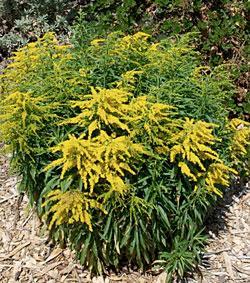
|
Sparaxis tricolor
Pronunciation
spa-RAKS-iss
Common Name
Harlequin Flower
Plant Type
Bulb
Mature Size
8-12 in. wide and 12 in. tall
Water Requirements
None: avoid summer water
Sun/Shade Requirements
Full sun
Wildlife
Flower Color
Red, pink, purple, while and yellow
Where to See
Maintenance- Design- Planting Tips
Sparaxis is a South African bulb with cheerful flowers and sword-shaped leaves. They come in an assortment of colors and look spectacular in a mixed planting. Best of all, they don't need summer water, but will tolerate water if irrigated.
Sparaxis is truly an easy plant that has few insect or disease problems and will naturalize without effort. The plants readily self sow. If leaves are left on until the seed pods open, more plants will grow the next year. These plants go dormant after blooming. PADG notes: After the leaves have lost most of their green color, they are snipped off a couple inches of above ground. Other master gardeners wait for the leaves to go completely brown and then they simply pull off the dead leaves. It isn't necessary to do this, but getting rid of brown dormant leaves gives the summer garden a more lush look. Unfortunately, snails and slugs love these plants. The leaves will generally show it unless snails are kept under control. |
Teucrium fruticans ‘Azureum’
Pronunciation
Tew-kree-um FREW-ti-kanz
Common Name
Bush Germander
Plant Type
Shrub
Mature Size
4 - 6 ft. tall and wide
Water Requirements
Low: water every three weeks until the root ball is wet
Sun/Shade Requirements
Full sun
Wildlife
Flower Color
Violet blue
Where to See
Maintenance- Design- Planting Tips
Teucium fruticans 'Azureum' has attractive blue flowers all winter long. The rest of the year it has a smaller floral display. The deep blue stands out against the grey foliage.
PADG Notes: A drawback to Bush Germander is it can grow to be very large. We pruned ours back to 4 inches to help control its size. The shrub came roaring back with a natural shape and a slightly smaller size. The winter blooms are plentiful. We recently planted a smaller Teucrium cultivar, 'Compactum' that is reputed to stay 3 feet tall and wide and have intense blue flowers. |
Trichostema lanatum
Pronunciation
try-CO-stem-uh la-NAY-tum
Common Name
Woolly Blue Curls
Plant Type
Shrub
Mature Size
3-4 ft. high & wide
Water Requirements
None: avoid summer water
Sun/Shade Requirements
Full sun
Wildlife
Flower Color
Violet to blue
Where to See
Maintenance- Design- Planting Tips
PADG Notes: We approached growing the California native Woolly Blue Curls with some trepidation because it has a reputation for being difficult. It is sensitive to over watering and poor draining soil and often is short lived. But it has beautiful flowers and foliage that smells like bubble gum when rubbed.
Several years ago, a Woolly Blue Curls plant was added to our California native plant bed. The plant was mulched with rock to improve drainage and received no additional summer water. It has bloomed and grown over the years, but it really wants a sunnier spot. The plant is reaching out for more light and has woody, unattractive stems. We’ve avoided cutting the plant back hard, because we have read it does not get new growth on old wood. Some sources suggest planting Woolly Blue Curls as an annual. In all honesty, if your heart is not set on a California native, there are probably easier low water plants with lavender flowers. Lavender and Mexican sage are two lavender flowered plants we think are safer choices for the novice gardener. |
Verbena bonariensis
Pronunciation
ver-BEE-na bo-nar-ee-EN-sis
Common Name
Verbena
Plant Type
Perennial
Mature Size
3-6 ft tall x 1-3 ft wide
Water Requirements
Low: water every three weeks until the root ball is wet
Sun/Shade Requirements
Full sun
Wildlife
Flower Color
Purple
Where to See
Maintenance- Design- Planting Tips
Best used as a background plant, Verbena bonariensis does best in hot, dry locations with good air circulation and well-draining soil.
This is a fast-growing plant, which if happy in the garden, will spread by seed. It has a small clump of green leaves that produce tall flowering stems in the hot summer months. The overall look is light and airy. Tall stems should be cut down when flowers have faded. PADG Notes: This plant is no longer in the garden because it needed some supplemental water to keep it thriving. |
Watsonia
Pronunciation
wat-SON-ee-uh
Common Name
Watsonia
Plant Type
Bulb
Mature Size
2 1/2 ft. tall and wide
Water Requirements
Low: water every three weeks until the root ball is wet
Sun/Shade Requirements
Full sun
Wildlife
Flower Color
Pink, rosy red, white, lavender, peach, orange
Where to See
Maintenance- Design- Planting Tips
Watsonia is a South African plant that grows well in the Santa Clara Valley. The pink gladiolus-like flowers are a highlight of late spring gardens. The sword-shaped leaves provide strong accent points in beds. Some retail nurseries carry a selection of Watsonia corms (bulbs) in the fall.
PADG Notes: This is a summer dormant plant, which means it can get by on almost no water in the summer but has unattractive leaves starting in July. We solve the ugly leaf problem by cutting the leaves back to a couple inches above ground in mid-summer. This results in a bare spot in the bed. If that bothers you, install a plant next to the Watsonia that will fill in the bare spot during the summer and fall months. |
Westringia fruticosa 'Wynyabbie Gem"
Pronunciation
west-RING-ee-uh froo-tih-KOH-suh
Common Name
Coast Rosemary
Plant Type
Shrub
Mature Size
3 - 6 ft. tall and 5 - 10 ft. wide
Water Requirements
Low: water every three weeks until the root ball is wet
Sun/Shade Requirements
Full sun
Wildlife
Flower Color
White to light lavender
Where to See
Maintenance- Design- Planting Tips
This shrub from Australia looks a lot like rosemary, but its leaves are finer and have no fragrance. It has light lavender flowers that appear in midwinter and last through spring.
Westringia grow into large plants so plan ahead or be prepared for a lot of pruning. Unlike rosemary, the stems of Westringia do not get woody, which makes it is a better long term landscaping choice. |







